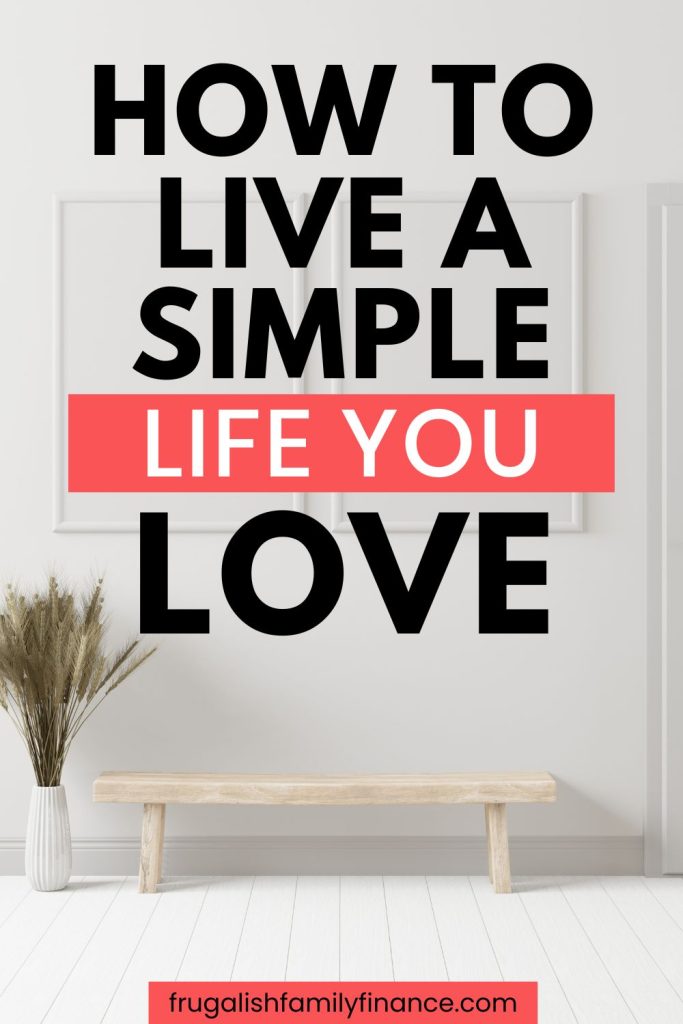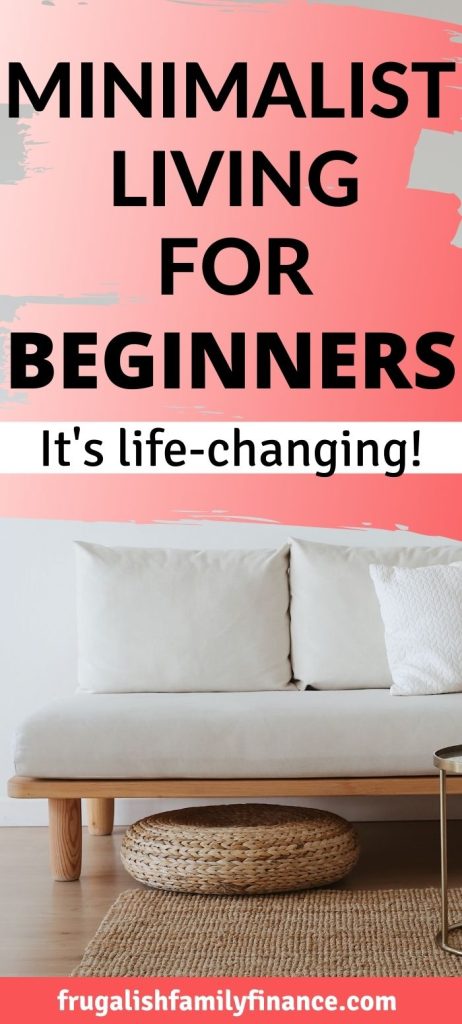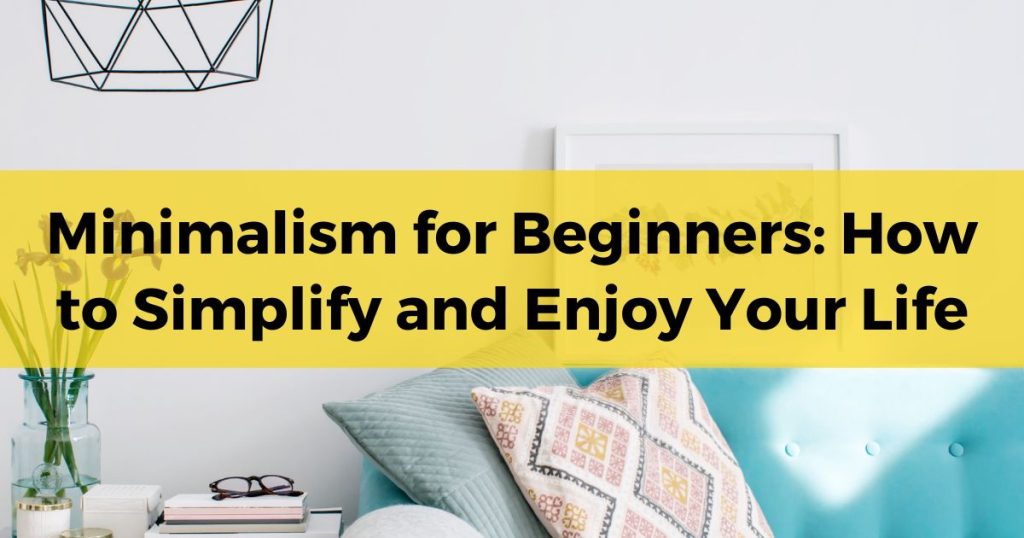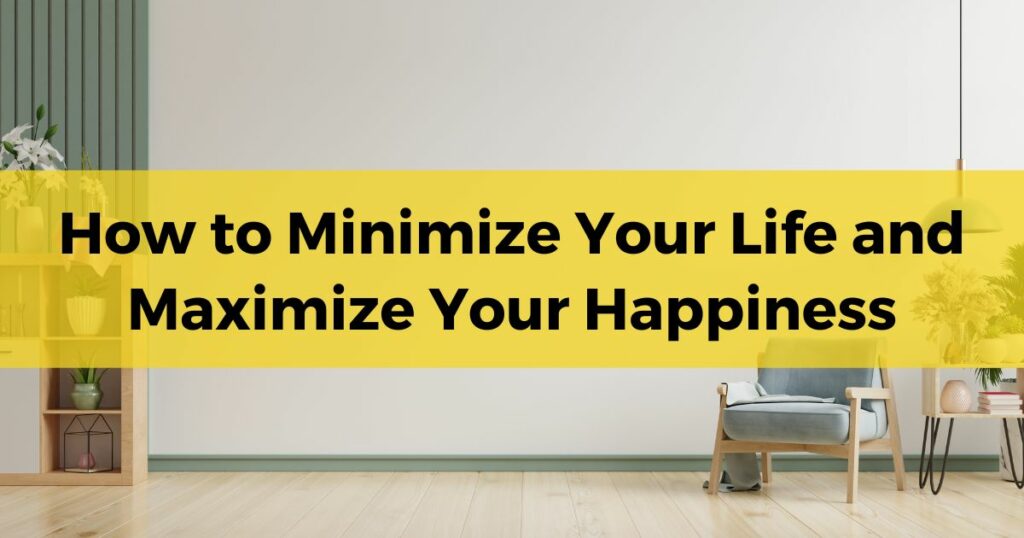Do you feel like all your stuff is suffocating you? Paring down on the number of things you own may help.
I came across a statistic that shocked the hell out of me! The average household has at least 300,000 things in their home!
That’s over a quarter of a million things! No wonder we all need bigger houses. We need more space to keep the pointless crap we hoard.
All this clutter ends up causing mental, physical, and financial stress.
That’s why we decided to live with less clutter. However, we didn’t do it on purpose at first.
A few years ago, we were in a ton of debt. We were stressed, and our anxiety was through the roof. We decided to sell a bunch of stuff to make some extra money.
Little did we know this motivation to make extra money would lead to our own minimalist journey. As we decluttered, our debt decreased, and so did our anxiety.
We didn’t even know what minimalism was at the time. We just knew it felt great to get rid of things, and making money selling them was a huge plus!
Eventually, we came across Minimalism: A Documentary about the Important Things on Netflix, and it smacked us square in the face. We were minimalist!
With more research, we found out that simple living decreases anxiety and depression. It actually makes you happier!
So if you’re curious about the whole minimalism thing and how it could help you, keep reading! Because I am going to tell you all about minimalism for beginners!
Disclaimer: This post may contain affiliate links. This means I receive a small commission, at no extra cost, if you purchase using the links below. Please see my earnings disclaimer for more details.
Table of Contents
What is minimalism?
Most people have a common misconception that minimalism is white walls, tiny home living, and having fewer than 100 things. That may be some people’s minimalism, but that’s not what minimalism is about.
The true meaning of minimalism is simplicity, living with fewer material possessions to live a more meaningful life.
It’s living with less stuff and more freedom!
Minimalism was made famous by Joshua Fields Millburn and Ryan Nicodemus (a.k.a. The Minimalist). But minimalism has actually been around for a long time.
The minimalist lifestyle originated in Japan and Scandinavia. While style varies, the minimalist lifestyle is all about living a calm, simple, and uncluttered life with only the essentials and some things that add beauty and function.
Why should you embrace minimalism?
We live in a world where consumer culture runs rampant. Everybody is waiting for the next big thing. Fast fashion, the newest tech, and the latest trends are cluttering up all aspects of your life.
Could you imagine a life where you slowed down just a bit? A life where you had less debt, less commitments, and less clutter? A life you could actually enjoy doing the things you wanted instead of working overtime to afford the next big thing or trying to keep up with all your monthly payments.
This is why minimalism is so appealing to most. It’s a big life change and a huge shift in mindset, but it helps you lead a more intentional life.
Why can’t I let go of clutter?
The hardest thing about minimalism is the decision to let go of things and then starting. I remember keeping clothes that were three sizes too small in hopes that I would one day fit into them or keeping things because I may need them. I also put a false sentimental value on things because I felt guilty getting rid of them.
This mindset keeps us stuck and unable to let go of the clutter that is suffocating us.

Benefits of minimalism
A minimalist lifestyle has many benefits, but here are the most life-changing ones (at least for me).
Less time cleaning
When you have fewer possessions, you have less to clean up! Therefore, you spend less time cleaning overall.
I can’t tell you how many hours I spent cleaning up toys and random things around the house and trying to find a place to put everything. We were bursting at the seams and it felt like we didn’t have enough space. Nothing had a “home,” and it looked cluttered even when the house was clean.
With minimalism, everything has a home, and everything has a purpose. And we no longer feel like we need more space. We have the right space for us, and I spend way less time cleaning it.
Less stress & anxiety
According to an article in Psychology Today, clutter floods our minds with excessive stimuli, which causes our senses to work in overdrive and signals to our brains that the work is never done. This causes an increase in stress, anxiety, and depression.
I noticed a positive shift in my stress level when we started to declutter. I was less anxious and didn’t feel like I always had to busy myself cleaning. I actually had time to breathe and enjoy my space.
Save more money
A minimalist lifestyle helps you to be more intentional with your spending. You’re more mindful of the things you bring into your space. Therefore, because you need and want less, you’ll spend less too!
Prioritize your time
You’ll free up more time because you’ll spend less time cleaning, organizing, and trying to find things. This extra time can be spent doing things that are enjoyable to you.
Pay off debt faster
Selling things around your house can be a great side hustle to help pay off debt. We were able to pay off a good chunk of debt by selling the stuff we were getting rid of.
Related:
How to Slay Your Debt Using the Debt Snowball
Turn Clutter into Cash: How to Declutter and Make Money
Ultimate Guide For How To Get Sales On Poshmark In 2023
Disadvantages of minimalism
A minimalist lifestyle can have some drawbacks, so let’s discuss them.
Most people will not understand
Because minimalism is a drastic change away from the norm of consumerism, many people will not understand. You may experience comments or unsolicited advice about your lifestyle.
It’s annoying, to be honest.
But when it comes down to it, it’s about how you want to live. What is best for you and your family?
A simpler life with less stuff, debt, and stress has afforded us more time to enjoy the beauty and things we want. This makes it easier to ignore the comments made about our own minimalism journey.
Gift-receiving can be awkward
When embracing a more minimalist lifestyle, gift-receiving can be awkward.
It can be challenging when you have kids. Grandparents and others will want to give you too many toys (and more) you don’t want. But you also can’t tell people how to spend their money, and it would cause conflict if you flat out refused them.
Here are a couple of ways to handle gifts in a way that won’t cause conflict (because we don’t want that!).
- Suggest an experience instead of more toys or things you don’t need if you’re asked for gift ideas. A family trip to the zoo or money towards dance lessons is more memorable than toys.
- When you get something new, get rid of something in its place. We do this for Christmas gifts. Usually, we’ll do a toy purge before Christmas, and then after, get rid of anything else we need to.
- You could try to explain your lifestyle to the gifter and ask that they respect your choices. But realize it’s ultimately their money, and they will do what they want regardless of your wishes.
Getting rid of toys can seem impossible
At first, it can be hard getting rid of toys because…
- You may feel guilty getting rid of toys people spend money on.
- Children are little hoarders!
I’m not sure if it’s only my kids, but they will hold on to everything. Just last night, my son wanted to sleep with a chunk of wood from his broken bed. He would not let me throw it away. It was a hill I was not prepared to die on, so I let him.
The secret is to model good habits to your children. I have found that if I talk to them while I am getting rid of my stuff, it’s easier for them to let go of their things as well. I don’t get rid of anything without their permission.
We choose a couple of toys at a time to donate to a child in need. Knowing their toys will be loved by someone who needs them helps make it easier for them.
We still have more toys than I care to have, but it’s a process. I have noticed some amazing things by paring down on the toys they have.
It cuts down stress and anxiety
Clutter (whether toy or general home clutter) can increase stress and anxiety in children. According to The Anxiety-Free Child Program, toy clutter can cause:
- Distraction and a shorter length of play
- Sensory overload with excessive stimuli
- A lack of creativity
I have noticed that my children play longer in one sitting with their toys, and they get less frustrated because they don’t have to search for the things they’re looking for.
Promotes creative play
According to Psychology Today, fewer toys lead children to engage in more creative and imaginative play, promoting healthier play and deeper cognitive development.
Fewer toys promote imagination, problem-solving, and self-expression.
We got rid of many noise-making toys because they were overstimulating for them and me. We kept the toys they could be creative with (legos, magnetic tiles, train sets, barbies, etc.). Do you know what happened? It was less noise, and they actually played with their toys…TOGETHER. It was amazing!
Teaches them to take care of their things
When a child only has limited toys to play with, they tend to take care of them more.
We really don’t buy toys. If we do, it’s for Christmas or Birthdays. So, our kids understand that we will not replace something if they break it. Therefore, they take care of their stuff.
Uncomfortable at first
Deciding to live with fewer material things is easy. The hard work is starting the decluttering process and getting rid of things.
I remember saying, “what if I get rid of this and need it“ or “what if I regret it and can never get it back.”
But as I started to remove things, I noticed I felt lighter and happier. This encouraged me to get rid of even more. It’s a process, though. Some things will be easy to let go of, and others may take months or even years to tackle. Eventually, it becomes second nature. You learn to assess your need for what you bring in and their role in your home.
Tips to get started with minimalism
Here are some minimalist tips to help you embrace a more simple life.
Stop bringing stuff in
A good way to start is a spending freeze. Unless it’s basic needs, stop buying stuff! This will help you get through your clutter without bringing more in. It will also help you save more money!
Figure out your why
Envision how your life would look with minimalism. Figure out the reasons why you want to embrace minimalism.
Do you’re kids have so many toys you spend your entire life picking up after them? Or perhaps, you feel like you’re drowning in clutter…financially, physically, and mentally.
Whatever your why is, it will help you understand what minimalism looks like for you and help you establish boundaries. It also helps to keep you motivated to continue decluttering.
Define your minimalism
My minimalism will most likely look very different from your minimalism.
Minimalism isn’t about living with nothing. It’s about simplifying and living with what you need and what brings you joy. There are no set rules for a minimalist lifestyle.
So, figure out what minimalist habits you want to adopt that will work for your family.

Find encouragement
Try to surround yourself with like-minded people or find some encouragement to get started. Here are some great minimalism resources to motivate you to start new habits.
- The Minimalist Podcast
- Minimalism: A Documentary About the Important Things (can rent on Amazon)
- The Minimalist: Less is Now (on Netflix)
- Be More With Less
- Project 333
- The Joy of Less: A minimalist Guide to Declutter, Organize, and Simplify
- The Life-Changing Magic of Tidying Up: The Japanese Art of Decluttering and Organizing
- Tidying Up with Marie Kondo (on Netflix)
- Sparking Joy with Marie Kondo (on Netflix)
Start slow
Doing too much at one time can be overwhelming. So, start slow, and you’ll naturally pick up momentum.
If you’re struggling to figure out what to part with, it’s best to work in phases.
Phase 1 (broken things or things you don’t want)
The easiest way to start is with broken things, duplicate items, or stuff you don’t want. Go through room by room and sort trash and donation items you feel comfortable getting rid of.
Phase 2 (stuff you’re holding on to but don’t use)
When you’re ready to get rid of more stuff, it’s time to move into phase 2. Get rid of the stuff you don’t use, but you’re holding on to, just in case.
If this is hard for you, you can try what we call the box method. We used this method when we were unsure if we would need something or not.
Go through all your stuff. If it’s not essential or you don’t love it, put it in a box. Stick the box in storage in your attic or garage. Put a time limit on it (ex. 3 to 6 months). If you need the item, you can grab it out during this time. At the end of the storage limit, you take the boxes to donation.
Phase 3 (get rid of more stuff)
Get rid of even more things! Phase 3 may come a couple of months or years later. It took us a couple of years to get to phase 3.
This phase is getting rid of the things we hold on to because we think they have meaning or that our kids will want when they get older.
I don’t know how many boxes of stuff we received from our childhoods that we didn’t want. It’s like those loved ones didn’t want the boxes of stuff but felt guilty getting rid of them. So, they shipped them off to us to deal with. Of course, instead of saying no thanks, we took them. So, they stayed up in our attic and garage, cluttering our space.
The thing is, we don’t have to hold on to stuff. We still have the memories with us. Here are a some examples of what we got rid of in phase 3.
- Most of the boxes our parents gave us!
- Picture albums and boxes of old photos (we digitized them)
- Kids artwork (digitized some that I wanted to keep)
- My wedding dress (donated to a good cause)
- Yearbooks
It’s ok to hold on to some things that have significant sentimental value. But when we label everything sentimental, nothing is truly sentimental. Try to think of the reasoning behind and the value of holding on to those items.
One room at a time
It can be overwhelming to tackle multiple rooms. To thoroughly go through everything, go one room at a time.
We started in the kitchen. We found it was easy to get rid of all the gadgets and small kitchen appliances we had accumulated over the years.
Don’t Compare
My minimalism will differ from yours, and a single-person or child-free couple’s minimalism will look completely different from a family with young kids.
Don’t get caught up in the Pinterest world of minimalism. The whole point of minimalist living is simplifying.
Minimalism will not solve all your problems
Minimalism will simplify your life, helping you to save money, time, and energy, but it’s not the be-all and end-all.
Minimalism is a tool to help you live a more fulfilling life, but it won’t do it all for you. You need to make changes in your life to best create the life you want to live.
Minimalism for beginners FAQs
Here are some of the most frequently asked questions about minimalism.
Why are minimalists are happier?
Although this post covers minimalism regarding your home and material goods, minimalism also branches out to your finances, digital consumption, and people in your life. Minimalism removes the excess from our lives and makes room to focus on prioritizing our values.
Therefore, minimalists lead a simpler lifestyle involving less stress and chaos, making for a happier home and life.
Related: How to Minimize Your Life and Maximize Your Happiness
What should you not to buy as a minimalist?
There are no hard and fast rules to what you can’t buy as a minimalist. But I will guide you on the things you shouldn’t buy.
Junk
When you make purchases, choose quality over quantity. Quality things will last longer, and junk is just a waste of money and space.
Impulse purchases
Stop and think before you buy. For anything that isn’t essential, you should take 24 hours and consider if you really need it. Most times, it was just an impulse buy.
Related: 4 Painful Consequences Of Overspending And How To Stop
Stuff on sale
Just because it’s a good deal or you have a coupon doesn’t mean you need it.
How many clothes should a minimalist own?
There is no set rules for the number of things you should have in your closet. But minimalists don’t usually participate in fast fashion.
They choose pieces as part of a capsule wardrobe that they can mix and match for each season. When needed, the pieces are replaced with a new article of clothing. Having a small capsule wardrobe makes it easier to pick out outfits and also makes for less laundry!
Related: 17 Frugal Laundry Tips To Save Money
What does a minimalist spend money on?
Minimalists spend their money on things essential to daily life and things that bring beauty and joy into their lives. They value quality over quantity. This may mean they have to wait and save for what they want because they typically do not prefer debt.
Related:
Everything You Need To Know About Sinking Funds For Beginners
23 Sinking Fund Categories to Help You Budget Better
What does a minimalist do with their time?
Anything they want! Minimalists not only declutter their homes but their calendars too. Minimalists don’t enjoy being busy just to be busy. If it’s not a heck yea, then it’s an absolute no.
What is the difference between decluttering and minimalism?
Decluttering is getting rid of things on the surface level. Minimalism helps us to learn what we can live without to create a calm, simple, and happier life.
Where do I start when I’m overwhelmed with clutter?
When we are feeling stuck or overwhelmed, the easiest place to start is with trash. Throw away things that are broken or are not working correctly. Working in phases (as discussed above) and using the box method will help you through the decluttering process and stay motivated.
Conclusion
If you feel like you need to downsize your life, minimalism may be for you. Living with less eliminates the stress and chaos from your life and frees up more time, money, and energy that you can use to live the life you want.
Remember, minimalism is different for everyone. So, figure out your why and what minimalism means to you. Then, start minimizing your life. Just making small changes can make a big impact.
What do you think about minimalism? Leave a comment below!



